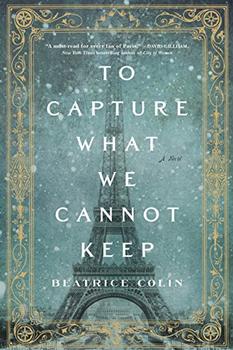Summary | Excerpt | Reading Guide | Discuss | Reviews | Beyond the Book | Read-Alikes | Genres & Themes | Author Bio

This article relates to To Capture What We Cannot Keep
 While looking into the real personalities of the characters in Beatrice Colin's To Capture What We Cannot Keep, I came to realize just how enlightening this book actually is, simply because of the hints Colin gives us into a time in history about which most of us know only a tiny part. Yes, we all know the Eiffel Tower, but little about Eiffel himself, nor do we know the other masterful civil engineers and architects of the time. For example, French engineer Émile Nouguier and Swiss engineer Maurice Koechlin designed and patented the pylons for the Eiffel Tower, without which the structure wouldn't have succeeded. Prior to this, Koechlin collaborated with none other than Gustav Eiffel for the structural elements required to build the Statue of Liberty.
While looking into the real personalities of the characters in Beatrice Colin's To Capture What We Cannot Keep, I came to realize just how enlightening this book actually is, simply because of the hints Colin gives us into a time in history about which most of us know only a tiny part. Yes, we all know the Eiffel Tower, but little about Eiffel himself, nor do we know the other masterful civil engineers and architects of the time. For example, French engineer Émile Nouguier and Swiss engineer Maurice Koechlin designed and patented the pylons for the Eiffel Tower, without which the structure wouldn't have succeeded. Prior to this, Koechlin collaborated with none other than Gustav Eiffel for the structural elements required to build the Statue of Liberty.
 One would think that with the Eiffel Tower and the Statue of Liberty, that Eiffel was more interested in decorative monuments than useful structures. However, this is far from the truth. Colin notes Eiffel's involvement with Ferdinand de Lesseps' project building the Panama Canal. While Eiffel didn't complete that project, his contribution to it was the series of locks to raise and lower ships passing through the canal by a stunning 85 feet, to bring them safely to the level of their destination ocean. This differed from the Suez Canal, another Ferdinand de Lesseps project, which is an artificial waterway between two seas, with no locks.
One would think that with the Eiffel Tower and the Statue of Liberty, that Eiffel was more interested in decorative monuments than useful structures. However, this is far from the truth. Colin notes Eiffel's involvement with Ferdinand de Lesseps' project building the Panama Canal. While Eiffel didn't complete that project, his contribution to it was the series of locks to raise and lower ships passing through the canal by a stunning 85 feet, to bring them safely to the level of their destination ocean. This differed from the Suez Canal, another Ferdinand de Lesseps project, which is an artificial waterway between two seas, with no locks.
 Eiffel's work can be seen in many structures across the globe, including buildings, bridges and viaducts. Only the continents of Australia/Oceania and Antarctica are left untouched by his legacy. I was most surprised to see two bridges listed in Vietnam, and a pier in Izmir, Turkey, thereby including Asia into the continents with his works. I was also surprised that the Statue of Liberty is the only project of his in North America (it was built in France and assembled in the USA). Finally, after thinking that it seemed like an egotistical move to name such an iconic tower after oneself, I was pleased to see that very few of Eiffel's projects carry his name. Perhaps that's why we know so little about Eiffel, and maybe it's about time we learn some more (although I'm sure French speakers know quite a bit more than I, at least). From what I can see, he was an innovator and risk-taker who deserves for his name to live forever on that lovely tower in Paris.
Eiffel's work can be seen in many structures across the globe, including buildings, bridges and viaducts. Only the continents of Australia/Oceania and Antarctica are left untouched by his legacy. I was most surprised to see two bridges listed in Vietnam, and a pier in Izmir, Turkey, thereby including Asia into the continents with his works. I was also surprised that the Statue of Liberty is the only project of his in North America (it was built in France and assembled in the USA). Finally, after thinking that it seemed like an egotistical move to name such an iconic tower after oneself, I was pleased to see that very few of Eiffel's projects carry his name. Perhaps that's why we know so little about Eiffel, and maybe it's about time we learn some more (although I'm sure French speakers know quite a bit more than I, at least). From what I can see, he was an innovator and risk-taker who deserves for his name to live forever on that lovely tower in Paris.
First drawing of the Eiffel Tower.
Construction phases of the Eiffel Tower, courtesy of Paris Eiffel Tower News
Top of the Eiffel Tower.
Filed under People, Eras & Events
![]() This "beyond the book article" relates to To Capture What We Cannot Keep. It originally ran in January 2017 and has been updated for the
October 2017 paperback edition.
Go to magazine.
This "beyond the book article" relates to To Capture What We Cannot Keep. It originally ran in January 2017 and has been updated for the
October 2017 paperback edition.
Go to magazine.
Your guide toexceptional books
BookBrowse seeks out and recommends the best in contemporary fiction and nonfiction—books that not only engage and entertain but also deepen our understanding of ourselves and the world around us.